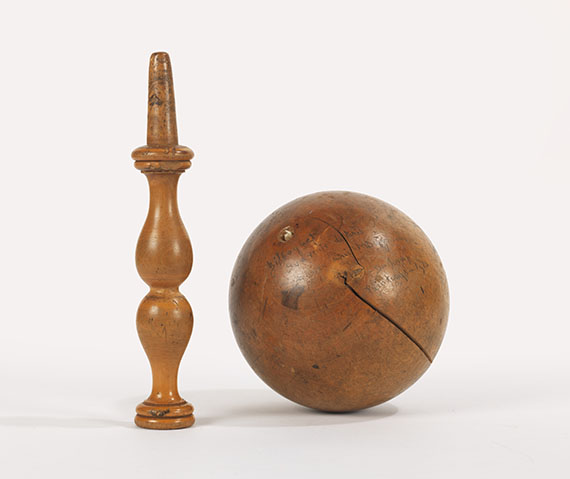Dictionary


Surrealism in Germany
The most important German surrealist Max Ernst (1891-1976) was mostly active in France, as the Cologne Dada protagonist, which earned him the nickname "Dadamax" in 1919, moved to Paris in 1922. He was connected to both the spontaneous Absolute Surrealism just as to Verist Surrealism. Max Ernst brought the technique of the collage to perfection at an early point. The method that takes things from their original context and puts them into new irrational correlations became a basic principle of Surrealism, it was referred to as "Combinatorics", a phenomenon that Max Ernst described in "Was ist Surrealismus?" (What's Surrealism) in 1934.
With his methods, the frottage, grattage, drippings and decalcomania, that are obliged to the surrealist automatism, Max Ernst was one of the groundbreaking innovators of Modernism, especially in terms of questions regarding techniques and material.
Besides Max Ernst, Richard Oelze (1900-80) from Magdeburg, he studied at the Weimar Bauhaus, is regarded one of the main representatives of German Surrealism. He got in touch with Surrealism in Paris, and made fascinating eerie landscapes, both in painting as well as in graphic art.
Hans Bellmer was also infected with Surrealism while in Paris, even though he did not get there before 1937. However, he had found his range of topics a few years earlier and almost exclusively depicted ominous erotic subjects that often reflected sadomasochistic fancies. His fetish-like "Puppen" (Puppets) were published in the surrealist magazine "Minotaure" in 1935.
Meret Oppenheim (1913-85), who had created a versatile oeuvre, left behind a main work of surrealist object art with her "Frühstücksgedeck in Pelz" (1936). Another main representative of German Surrealism is Edgar Ende, who successfully realized the style in different variations as of the 1930s and then again after World War II.
The most important German surrealist Max Ernst (1891-1976) was mostly active in France, as the Cologne Dada protagonist, which earned him the nickname "Dadamax" in 1919, moved to Paris in 1922. He was connected to both the spontaneous Absolute Surrealism just as to Verist Surrealism. Max Ernst brought the technique of the collage to perfection at an early point. The method that takes things from their original context and puts them into new irrational correlations became a basic principle of Surrealism, it was referred to as "Combinatorics", a phenomenon that Max Ernst described in "Was ist Surrealismus?" (What's Surrealism) in 1934.
With his methods, the frottage, grattage, drippings and decalcomania, that are obliged to the surrealist automatism, Max Ernst was one of the groundbreaking innovators of Modernism, especially in terms of questions regarding techniques and material.
Besides Max Ernst, Richard Oelze (1900-80) from Magdeburg, he studied at the Weimar Bauhaus, is regarded one of the main representatives of German Surrealism. He got in touch with Surrealism in Paris, and made fascinating eerie landscapes, both in painting as well as in graphic art.
Hans Bellmer was also infected with Surrealism while in Paris, even though he did not get there before 1937. However, he had found his range of topics a few years earlier and almost exclusively depicted ominous erotic subjects that often reflected sadomasochistic fancies. His fetish-like "Puppen" (Puppets) were published in the surrealist magazine "Minotaure" in 1935.
Meret Oppenheim (1913-85), who had created a versatile oeuvre, left behind a main work of surrealist object art with her "Frühstücksgedeck in Pelz" (1936). Another main representative of German Surrealism is Edgar Ende, who successfully realized the style in different variations as of the 1930s and then again after World War II.
Offers for Surrealism
Headquarters
Joseph-Wild-Str. 18
81829 Munich
Phone: +49 89 55 244-0
Fax: +49 89 55 244-177
info@kettererkunst.de
Louisa von Saucken / Undine Schleifer
Holstenwall 5
20355 Hamburg
Phone: +49 40 37 49 61-0
Fax: +49 40 37 49 61-66
infohamburg@kettererkunst.de
Dr. Simone Wiechers / Nane Schlage
Fasanenstr. 70
10719 Berlin
Phone: +49 30 88 67 53-63
Fax: +49 30 88 67 56-43
infoberlin@kettererkunst.de
Cordula Lichtenberg
Gertrudenstraße 24-28
50667 Cologne
Phone: +49 221 510 908-15
infokoeln@kettererkunst.de
Hessen
Rhineland-Palatinate
Miriam Heß
Phone: +49 62 21 58 80-038
Fax: +49 62 21 58 80-595
infoheidelberg@kettererkunst.de
We will inform you in time.




